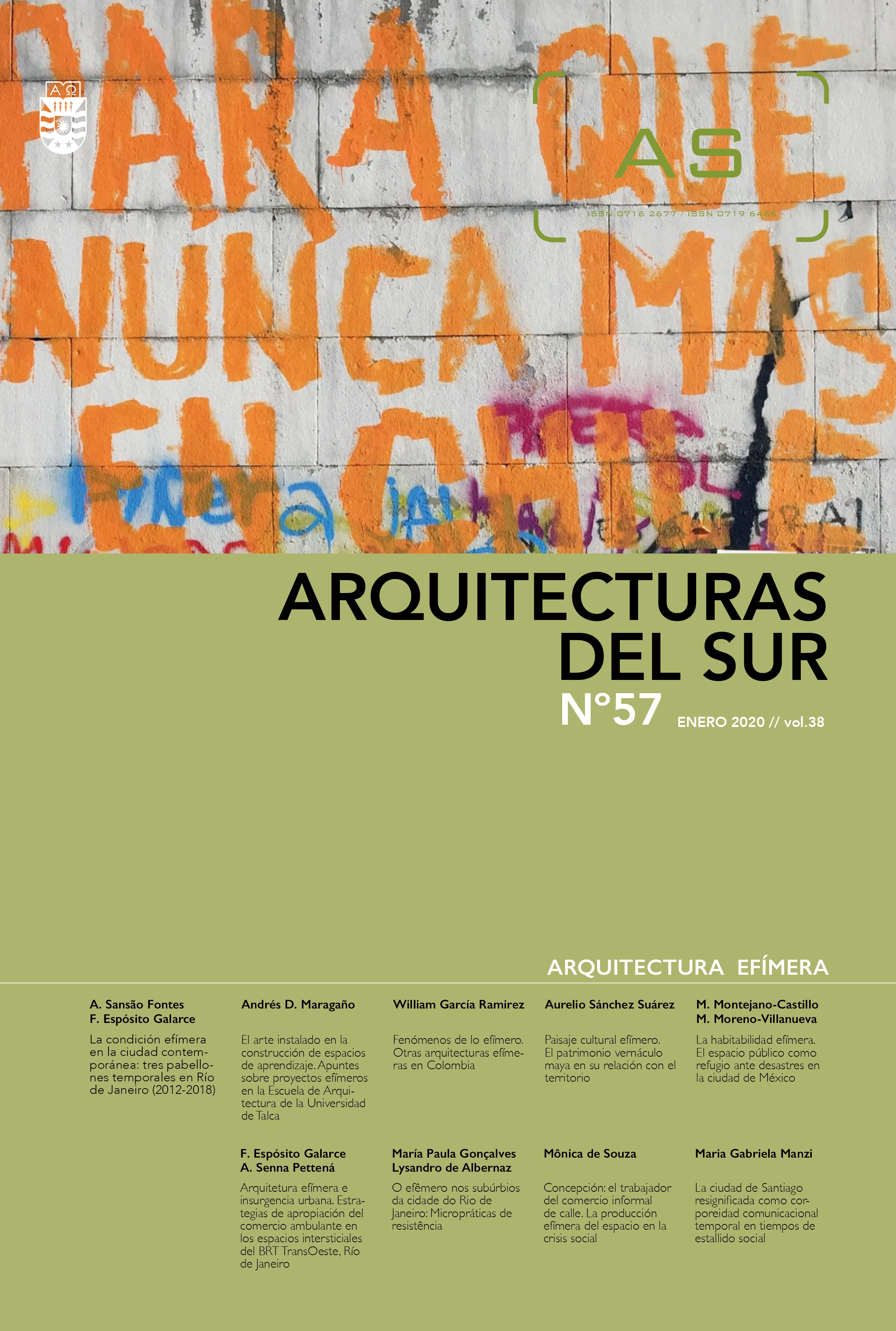The ephemeral in Rio de Janeiro’s suburbs: Micro-practices of resistance
DOI:
https://doi.org/10.22320/07196466.2020.38.057.07Keywords:
urban analysis, ephemeral architecture, suburban areas, public space, spontaneous architectureAbstract
This article looks at ephemeral situations which emerge in the appropriation of public space in the neighborhoods of Olaria, Ramos e Bonsucesso, suburbs of the city of Rio de Janeiro. These situations were identified in a study of urban singularities, motivated by concerns for the coherence of an urban intervention with respect to the complexities of the city’s contemporary reality. Our investigative approach stemmed from a spatial analysis on a micro scale, which considered the relationship between the city’s fabric and day to day events, enabling us to understand the effects of urban form on those who experience it daily. The theoretical concept of singularity, on which this study relies, is understood here as the result of the use of ingenuity and adaptation to prevailing conditions in contexts dominated by hegemonic processes. Such resistance enables local agents to remain in situ, contributing to the urban environment’s diversity. Due to the identification of multiple ephemeral situations of singularity during our investigation, we additionally incorporated the concept of ephemeral architecture into our theoretical-methodological framework. Based on this notion, architecture is conceived of as a generator of spatiality which is at once fleeting, organic and flexible and which requires little financial or human resources, relying on “bottom up” action. The ephemeral situations identified in Rio de Janeiro´s suburbs are understood as distinct from frequently studied “micro practices”, given their socioeconomic characteristics. As such, the notion of ephemeral architecture may contribute towards social and spatial urban inclusion, although considering the difficulty for urban design to deal with informality; environmental and landscape decay, as well as precarious infrastructure. Anyway, it is important to include in the process a system of design rules to guide spatial appropriation collectively conceived; as well as the adoption of solutions to deal with the reinstalling devices daily.
Downloads
References
ALBERNAZ, M. P. Olhares para os subúrbios da Leopoldina a partir de Bonsucesso, Ramos e Olaria. En J. S. &, R. M. &, T. G. Editores (Ed.). Diálogos Suburbanos: Identidades e lugares na construção da cidade . 2019b, pp. 87-114. Rio de Janeiro, RJ: Mórula Editorial.
ALBERNAZ, M. P. Suburbanização carioca: reflexos de uma identidade construída na configuração do Engenho Novo. En Urbana: revista eletrônica do Centro Interdisciplinar de Estudos sobre a Cidade (dossiê Suburbanización en Latinoamerica, 2019ª, Vol. 11, N.1 [20], jan-abril/2019, pp.93-120). https://periodicos.sbu.unicamp.br/ojs/index.php/urbana. Acesso em 15/11/2019.
AURELI, P. V. The Project of Autonomy: Politics and Architecture within and against Capitalism. New York, NY: The Princeton Architectural Press. 2008.
AURELI, P. V.The Possibility of an Absolute Architecture. Cambridge, Mass: MIT Press. 2011.
BALEM, T. Microurbanismo efêmero: entre táticas de construir e revelar a cidade. En Anais do XVII ENANPUR, 2017. São Paulo.
BISHOP, P., & WILLIAMS, L.The Temporary City. Abingdon, Reino Unido: Routledge. 2012.
BRENNER, Neil. Seria o urbanismo tático uma alternativa ao urbanismo neoliberal? En: E-metropolis-revista eletrônica de estudos urbanos e regionais (n.27, ano 7, pp.6-18, dez 2016). Recuperado de http://emetropolis.net/system/artigos/arquivo_pdfs/000/000/201/original/emetropolis27_capa.pdf?1485998522.
CÂMARA METROPOLITANA DE INTEGRAÇÃO GOVERNAMENTAL. Caderno metropolitano 1: a retomada do planejamento. 2015. Rio de Janeiro. Recuperado de http://www.camarametropolitana.rj.gov.br/cadernos/CADERNO1.pdf
CERTEAU, M. de. A invenção do cotidiano: artes de fazer. Petrópolis, RJ: Vozes. 2014.
FONTES, A. S. Intervenções temporárias, marcas permanentes. Apropriações, arte e festa na cidade contemporânea. Rio de Janeiro: Casa da Palavra. 2013.
GORELIK, Ad. Miradas sobre Buenos Aires: Historia cultural y crítica urbana. Buenos Aires, Argentina: Siglo Veintiuno. 2004.
GUATTARI, F., & ROLNIK, S. Micropolíticas: cartografias do desejo. Petrópolis, RJ: Vozes. 1996.
HABRAKEN, J. The Structure of the Ordinary: Form and Control in the Built Environment. Cambridge, Mass: MIT Press. 1998.
HOUAISS, A. Grande Dicionário Houaiss da Língua Portuguesa. Rio de Janeiro, RJ: Instituto Antônio Houaiss. 2001.
LYDON, M., & GARCIA, A. Tactical urbanism. Short-term action for long-term change. Washington, DC: Island Press. 2015.
MORIN, E. Introdução ao pensamento complexo. Porto Alegre, RS: Sulina. 5a ed. 2015.
PANERAI, P. Análise urbana. Editora Universidade de Brasília, DF. 2006.
ROSA, M. Micro: Planejamento Práticas urbanas criativas (org). São Paulo, SP: Editora de Cultura. 2011.
ROSSI, A. A arquitetura da cidade. Lisboa: Edições Cosmos. 1977.
SÁNCHEZ, M. L. Territorios de excepción: la CV500 como laboratorio de arquitectura. Tesis doctoral de la Universidad Politecnica de Madrid. 2015.
SANTOS, M. (2001). Por uma outra globalização: do pensamento único à consciência universal. São Paulo, SP: Record. 2001.
SOLÀ-MORALES, M. de. De cosas urbanas. Barcelona: Editorial Gustavo Gili. 2008.
Downloads
Published
How to Cite
Issue
Section
License
The content of the articles published in each issue of Arquitecturas del Sur is the sole responsibility of the authors and does not necessarily represent the opinion of University of the Bío-Bío.
The authors will maintain their copyright; however, they will guarantee the journal the right to first publication and dissemination of their work. The publication of the article in Arquitecturas del Sur will be subject to the Creative Commons International license (CC BY-SA) that allows others to adapt: remix, transform and build on the material for any purpose, even commercially; share: copy and redistribute the material in any medium or format, as long as the authorship and first publication in this journal are acknowledged by citing them correctly, and their new contributions are under a license with the same terms.














 Programa de Información Científica/Concurso Fondos de Publicación de Revistas Científicas 2018/ Proyecto Mejoramiento de Visibilidad de Revistas UBB (Código:FP180007)
Programa de Información Científica/Concurso Fondos de Publicación de Revistas Científicas 2018/ Proyecto Mejoramiento de Visibilidad de Revistas UBB (Código:FP180007) 
